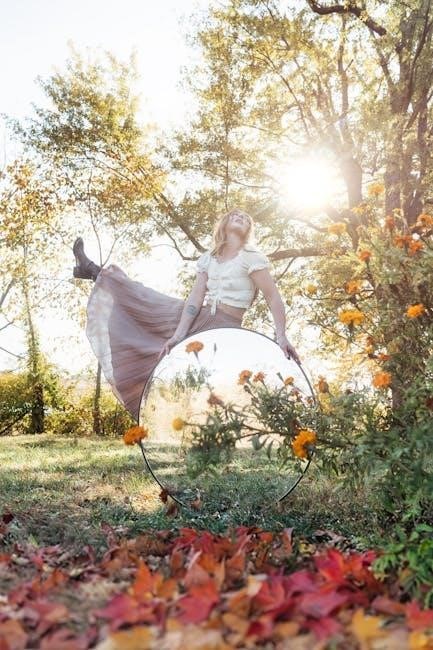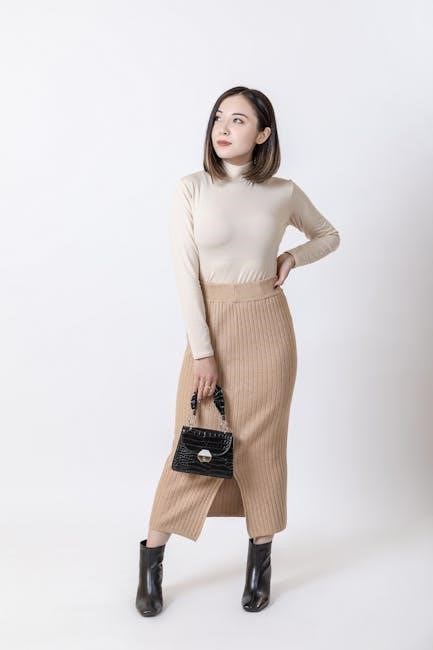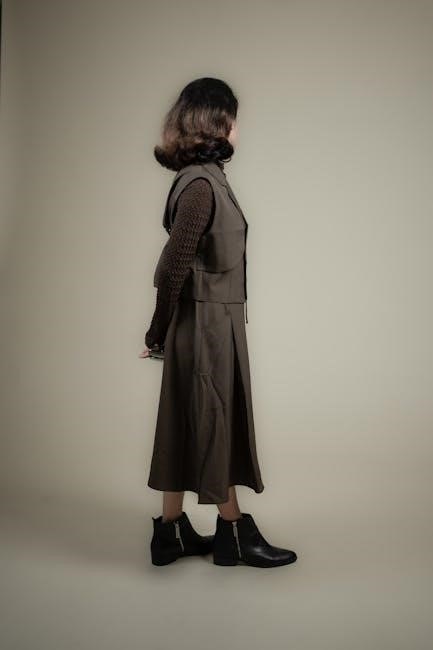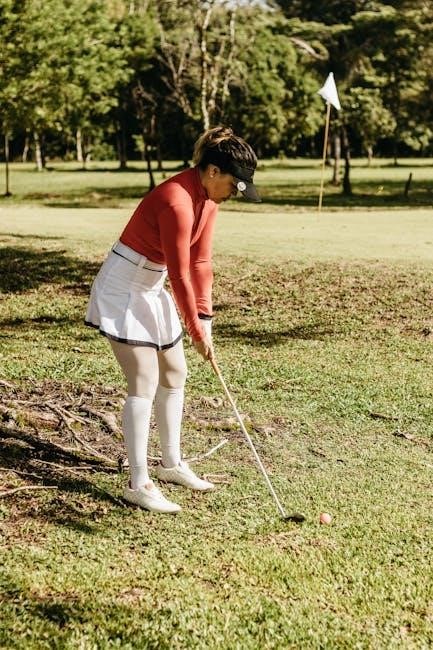Skirt lengths are a fundamental aspect of fashion, offering versatility and style. From mini to maxi, each length flatters differently, making it essential to choose the right one for your frame and occasion. Understanding skirt lengths helps in creating balanced outfits, boosting confidence and personal expression. This guide explores various skirt lengths, their impact, and how to select the perfect fit for any body type or event.

1.1 Understanding Skirt Length Terminology
Understanding skirt length terminology is crucial for making informed fashion choices. Common terms include mini, midi, and maxi, each describing the skirt’s length relative to the body. A mini skirt typically falls above the knee, while a midi skirt reaches just below the knee. A maxi skirt extends to the ankles or floor. Other terms like knee-length and tea-length (falling between the knee and midi length) also describe specific measurements. These terms help in identifying styles that flatter different body types and suit various occasions, making them essential for both shoppers and stylists.
1.2 Importance of Skirt Length in Fashion
Skirt length plays a crucial role in fashion, as it significantly impacts the overall aesthetic and functionality of an outfit. The right length can create balance, flatter body proportions, and enhance confidence. Whether for casual or formal events, skirt lengths adapt to diverse styles, making them versatile wardrobe staples. They also reflect current trends, with variations like mini, midi, and maxi skirts offering options for every preference. Understanding the importance of skirt length ensures a polished look, aligning with personal style and occasion. It’s a detail that elevates fashion from basic to exceptional, making it a key consideration for anyone curating their wardrobe.

Common Skirt Lengths
Skirts come in various lengths: mini, midi, maxi, and variations like knee-length and tea-length. Mini skirts are short, midi reach the calves, and maxi are floor-sweeping, offering diverse styling options.
2.1 Mini Skirts
Mini skirts are a bold and youthful fashion choice, typically measuring between 52cm to 57cm in length. They hit just above the knee, creating a chic, modern look. Ideal for confident individuals, mini skirts are perfect for casual outings or trendy events. Pair them with tights or leggings for a seasonal twist. They flatter petite frames and taller individuals alike, offering a versatile option for various body types. Mini skirts are a timeless piece, blending effortlessly with boots, heels, or sneakers, making them a must-have in any wardrobe. Their short length accentuates legs, adding a playful touch to any outfit.
2.2 Midi Skirts
Midi skirts are a timeless choice, typically hitting just below the knee, with lengths ranging from 52cm to 62cm. They offer a balanced look, suitable for both casual and formal occasions. Versatile and flattering, midi skirts complement most body types, creating a harmonious silhouette. They are ideal for those who prefer coverage without sacrificing style. Pair midi skirts with heels for elegance or sneakers for a relaxed vibe. This length is perfect for showcasing statement shoes while maintaining modesty. Its universal appeal makes it a wardrobe staple, adaptable to various fashion trends and personal preferences.

2.3 Maxi Skirts
Maxi skirts are a timeless and versatile choice, typically reaching just above the ankle or even the floor, with lengths around 62cm. They offer a elegant, flowing silhouette, suitable for all body types. These skirts are perfect for creating a balanced look, especially for taller individuals, as they elongate the legs. Maxi skirts are ideal for both casual and formal occasions, pairing well with heels or flats. Their length provides coverage and comfort, making them a popular choice for seasonal transitions. Styling options include adding a belt to define the waist or pairing with statement accessories for a polished appearance. Fabric choice greatly impacts the drape and movement of maxi skirts, ensuring a flattering fit for every wearer.

2.4 Other Variations (Knee-Length, Tea-Length, etc.)
Beyond mini, midi, and maxi skirts, there are other variations that offer unique styling options. Knee-length skirts hit just above the knee, creating a balanced, modest look. Tea-length skirts, also known as midi skirts, fall between the knee and calf, adding a vintage touch. For petite frames, skirts just above the knee can elongate the legs, while taller individuals might prefer slightly longer knee-length styles. Asymmetrical or high-low hem skirts combine shorter fronts with longer backs for a trendy, dynamic appearance. These variations provide versatility, allowing individuals to choose a length that complements their body type and personal style effortlessly.

Skirt Lengths by Body Type
Skirt lengths complement different body types, enhancing proportions. Petite frames look great in mini skirts, while tall individuals can wear maxi styles. Understanding your body type helps choose the most flattering skirt length, ensuring a balanced and stylish look.
3.1 Petite Frames
Petite frames, typically 5’4″ or shorter, benefit from skirt lengths that create balance and proportions. Mini skirts ending just above the knee are ideal, as they elongate the legs without overwhelming the frame. Midi skirts should hit just below the knee to avoid shortening the appearance of the legs. Maxi skirts can work if paired with heels or a fitted top to maintain balance. Avoid overly voluminous fabrics, as they can overwhelm a petite silhouette. Structured or A-line skirts are flattering, as they skim the body without adding bulk. Pairing skirts with point-toe shoes or heels enhances the lengthening effect, creating a more balanced look for petites.

3.2 Hourglass Figures
Hourglass figures, characterized by a balanced bust and hips with a defined waist, look stunning in skirts that accentuate their curves. Pencil skirts and A-line styles are ideal, as they hug the waist and flare slightly, creating a flattering silhouette. Mini skirts can also work well, drawing attention to the legs while emphasizing the waist. For a more elegant look, midi skirts that hit just above the knee are perfect, as they elongate the legs without overwhelming the frame. Pairing these skirts with fitted tops or adding a belt can further highlight the waist, enhancing the hourglass shape. This balance creates a timeless, feminine appeal.
3.3 Pear-Shaped Bodies
Pear-shaped bodies, characterized by a smaller upper body and curvier hips and thighs, benefit from skirts that balance proportions. A-line skirts are ideal as they skim over the hips, creating a more balanced silhouette. Midi and maxi skirts also work well, as they draw attention away from the hips and elongate the legs. Avoid overly tight or short skirts that accentuate the lower half. Instead, opt for structured fabrics and details like pockets or belts to add shape. Pairing with fitted tops or jackets can further enhance balance. The right skirt length can create harmony and boost confidence for pear-shaped individuals.
3.4 Tall Individuals
Tall individuals can effortlessly pull off a variety of skirt lengths, but certain styles enhance their proportions. Midi and maxi skirts are ideal for creating balance, as they elongate the legs further while maintaining grace. Knee-length skirts are also flattering, as they highlight the calves without overwhelming the frame. For a chic look, tall women can opt for mini skirts paired with heels to emphasize their height. Additionally, A-line skirts in longer lengths can create a balanced silhouette. When styling, monochromatic outfits or high-waisted designs can further enhance the tall, lean appearance. Proper fit and proportion are key to making the most of skirt lengths for taller individuals.
How to Measure Skirt Length
Measure skirt length from the natural waist down to the desired hemline. Stand straight, place the tape measure at your waist, and extend it along your leg to the preferred length. Ensure accuracy by keeping the tape taut and level. This method applies universally, regardless of body type or fabric, providing a consistent way to determine skirt length effectively.
4.1 Proper Measuring Techniques
Proper measuring techniques ensure accuracy when determining skirt length. Stand straight and measure from your natural waist down the side of your leg to your desired hemline. Use a flexible tape measure, keeping it level and parallel to the floor. For skirts, measure from the top of the waistband to the bottom of the hem. Consider your inseam, as it can affect how the skirt fits. Always measure in the same stance and clothing to maintain consistency. Double-check your measurements to avoid errors, ensuring the perfect fit for your chosen skirt style.
4.2 Inseam vs. Skirt Length
Understanding the difference between inseam and skirt length is crucial for accurate measurements. Inseam refers to the measurement of the inside of the leg, typically from the crotch to the ankle, while skirt length measures from the waist to the hem. Skirt length is always longer than inseam, as it extends beyond the leg. For example, a skirt with a 52cm length will have a shorter inseam, around 13cm. This distinction helps in determining the right fit and style, ensuring the skirt falls correctly on the body. Proper measurement techniques are essential to avoid confusion between these two terms.
Skirt Length and Fabric
Fabric choice significantly impacts skirt length aesthetics. Lighter fabrics suit shorter styles, while heavier materials enhance longer skirts. Seasonal preferences also influence fabric and length pairings for optimal comfort and style.
5.1 Fabric Types and Their Impact on Skirt Length
Fabric plays a crucial role in determining the ideal skirt length. Flowy fabrics like chiffon or silk naturally drape well, making them perfect for longer skirts, while structured fabrics like wool or tweed are better suited for shorter, more defined styles. Lightweight materials such as cotton or linen are ideal for midi or mini skirts, offering a casual, effortless look. Conversely, heavier fabrics like velvet or corduroy are often paired with maxi skirts for a dramatic, seasonal appeal. The texture and weight of the fabric can enhance or limit the skirt’s movement, making it essential to consider fabric type when choosing a skirt length for the desired aesthetic and functionality.

5.2 Seasonal Considerations for Skirt Lengths
Seasonal considerations play a significant role in choosing the right skirt length. For summer, lightweight fabrics like cotton and shorter lengths such as mini or midi skirts are ideal for breathability and comfort. In autumn, midi and knee-length skirts in warmer fabrics like wool or velvet are perfect for cooler weather. Winter calls for maxi skirts paired with thick tights and boots, while spring brings tea-length skirts in medium-weight fabrics. Layering and accessories like belts or scarves can enhance seasonal appropriateness. Understanding these seasonal nuances helps in creating outfits that are both stylish and practical for any time of the year.

Skirt Length Trends
Current trends feature midi and maxi skirts as staples, while mini skirts make a comeback. Styling varies, with accessories and shoes enhancing each length’s appeal seasonally.
6.1 Current Trends in Skirt Lengths
Current trends in skirt lengths emphasize versatility, catering to diverse styles and preferences. Mini skirts remain popular for their bold, youthful appeal, while midi skirts offer a chic, sophisticated alternative. Maxi skirts continue to dominate as a comfortable yet elegant option. Asymmetrical hems and tiered designs are also gaining traction, adding a modern twist to traditional silhouettes. Seasonal fabrics, such as lightweight cotton for summer and heavy wool for winter, further influence skirt length choices. These trends highlight the adaptability of skirts, ensuring there’s a style to suit every body type, occasion, and personal aesthetic.
6.2 How to Style Different Skirt Lengths
Styling different skirt lengths requires thoughtful pairing with tops, shoes, and accessories. For mini skirts, balance proportions with tights and ankle boots, or go bold with thigh-high boots. Midi skirts look chic with cropped tops or tailored jackets, while maxi skirts can be dressed up with a belt and heels or down with sneakers. Knee-length skirts are versatile, pairing well with blazers for a professional look or with a cozy sweater for casual outings. Tea-length skirts are perfect for vintage-inspired outfits, layered with cardigans. Experiment with textures, colors, and layers to create outfits that flatter your figure and reflect your personal style effortlessly.
Skirt Length and Accessories
Skirt length and accessories go hand in hand. The right shoes can elongate or shorten the appearance of legs, while a belt can define the waist perfectly, balancing the outfit.
7.1 Choosing the Right Shoes
Choosing the right shoes to pair with your skirt length is crucial for a polished look. For mini skirts, opt for high heels or ankle boots to elongate your legs. Midi skirts pair well with loafers or sneakers for a casual vibe, while stilettos can add elegance. Maxi skirts complement sandals or wedges, creating a balanced silhouette. Consider the skirt’s fabric and occasion—metallic or embellished shoes for formal events, and neutral tones for everyday wear. Ensure the shoe height aligns with the skirt length to avoid overwhelming the outfit. The right footwear enhances both comfort and style, making your skirt stand out.
7.2 Adding a Belt or Sash
A belt or sash can elevate your skirt outfit by defining your waistline and adding a stylish touch. Choose a belt that complements the skirt’s fabric and color, ensuring it enhances the overall look. For example, a wide leather belt pairs well with a maxi skirt, while a delicate sash suits a midi skirt. The material and width of the belt should align with the skirt’s design and the occasion. Positioning the belt at your natural waist creates a balanced silhouette, accentuating your figure. This accessory not only adds polish but also allows for effortless personalization, making your skirt stand out in any setting.

Skirt Length Chart
A skirt length chart provides standard measurements, helping you choose the perfect fit based on your body type and personal style preferences, ensuring a flattering look.
8.1 Standard Skirt Length Measurements
Standard skirt length measurements vary, but common lengths include mini skirts at 52-57cm, midi skirts at 57-62cm, and maxi skirts at 62cm or longer. These measurements are typically taken from the natural waist down to the hem. Mini skirts usually fall above the knee, midi skirts hit just below the knee, and maxi skirts reach the ankles or floor. Some brands may slightly vary these standards, but they provide a general guide for shoppers. Understanding these measurements helps in selecting skirts that fit personal style and body proportions effectively.
8.2 How to Use a Skirt Length Chart
Using a skirt length chart is straightforward. Start by identifying your height and body type, then match it to the chart’s measurements. Measure from your natural waist to your desired hemline to determine your ideal skirt length. Compare this measurement to the chart to find the corresponding skirt length category. For example, if your measurement is 62cm, it aligns with a midi skirt. Adjust based on personal preference or occasion. Consider fabric weight and seasonality to ensure the skirt drapes well. This method ensures a flattering fit, helping you choose the perfect skirt length for any outfit or event.
Conclusion
Choosing the right skirt length enhances your style and confidence. Consider your body type, occasion, and personal preference to make the best choice. Happy styling!
9.1 Final Tips for Choosing the Right Skirt Length
When selecting a skirt length, ensure it aligns with your body proportions and personal style. Measure from your natural waist to desired hemline for accuracy. Petite frames benefit from shorter lengths like mini or knee-length skirts, while taller individuals can pull off midi or maxi styles effortlessly. Consider the occasion—mini skirts for casual outings, midi for versatility, and maxi for elegance. Pair your skirt with appropriate shoes to enhance proportions. Don’t forget to accessorize thoughtfully, as belts or sashes can redefine your silhouette. Ultimately, choose a length that makes you feel confident and comfortable, as confidence elevates any outfit.


